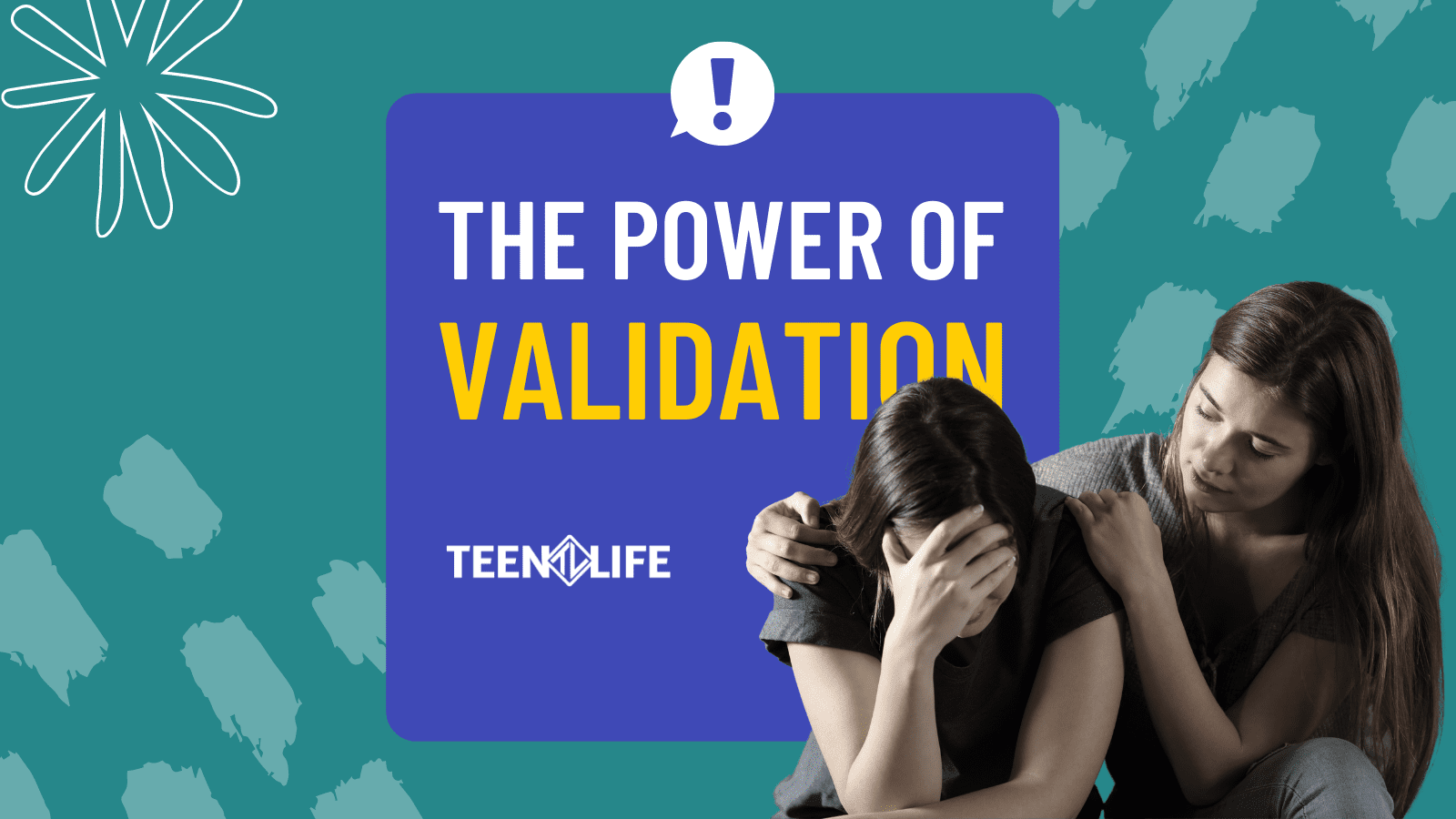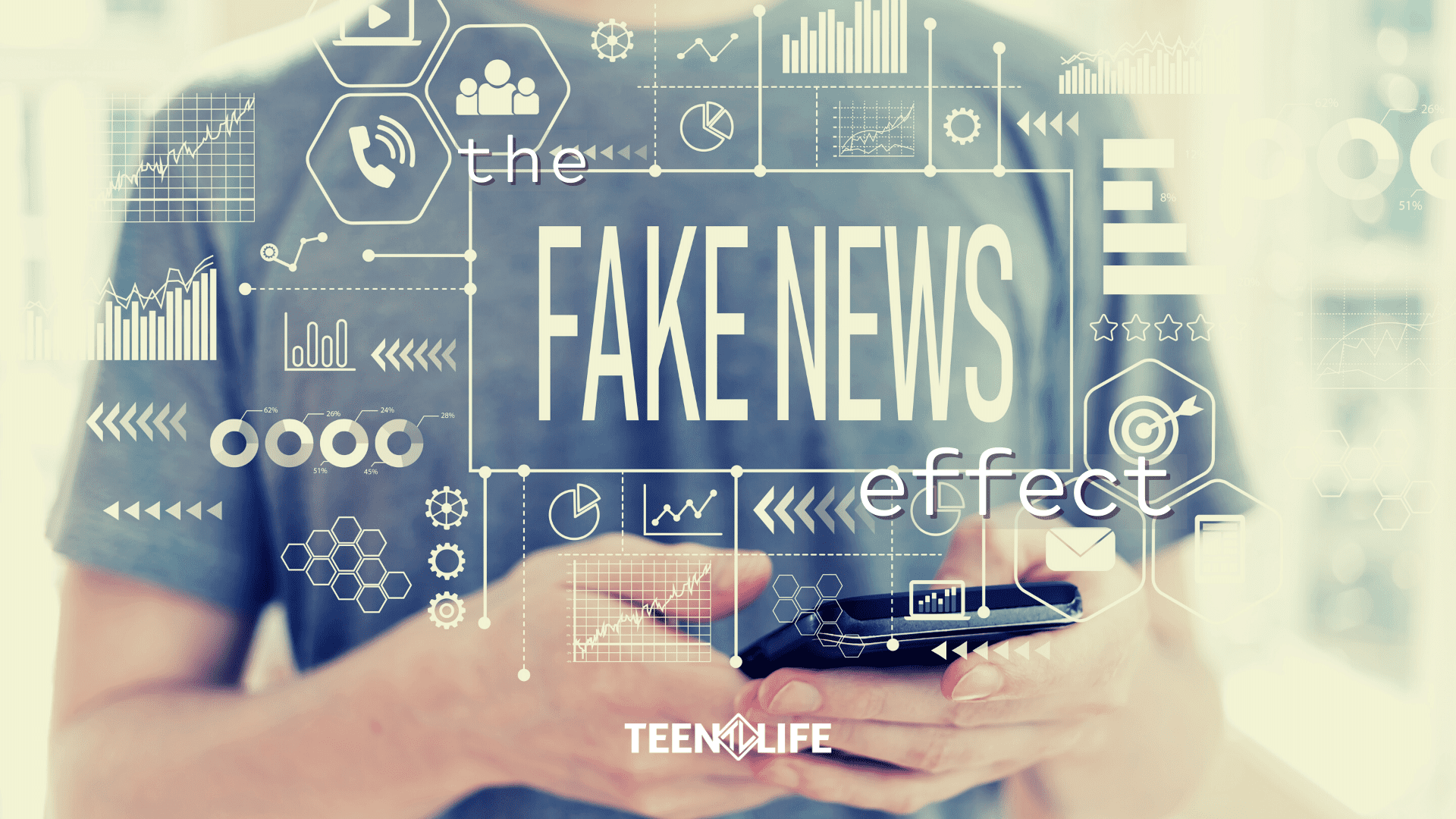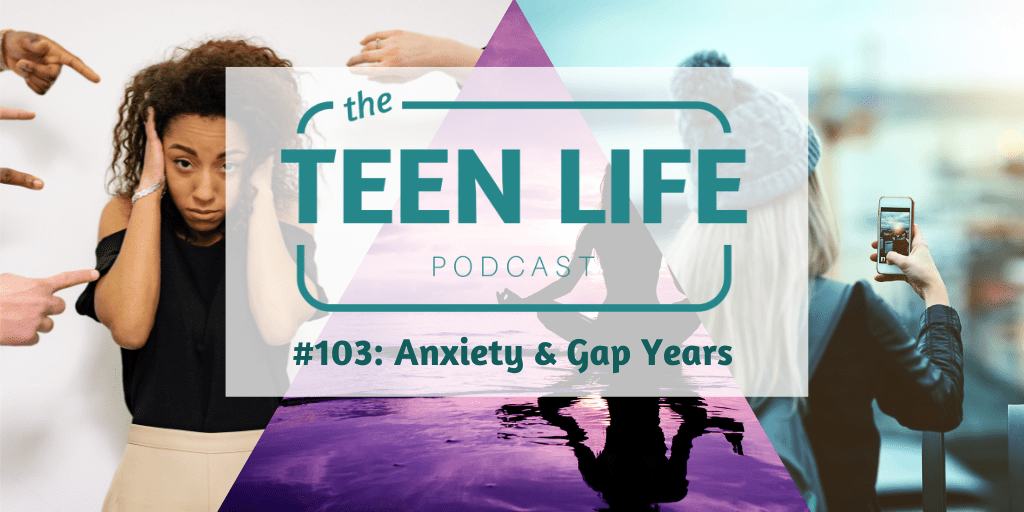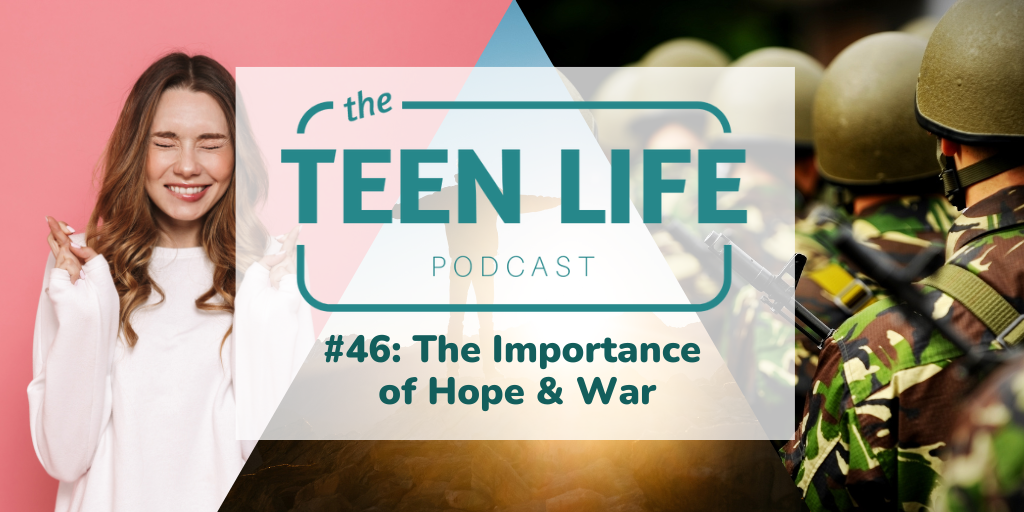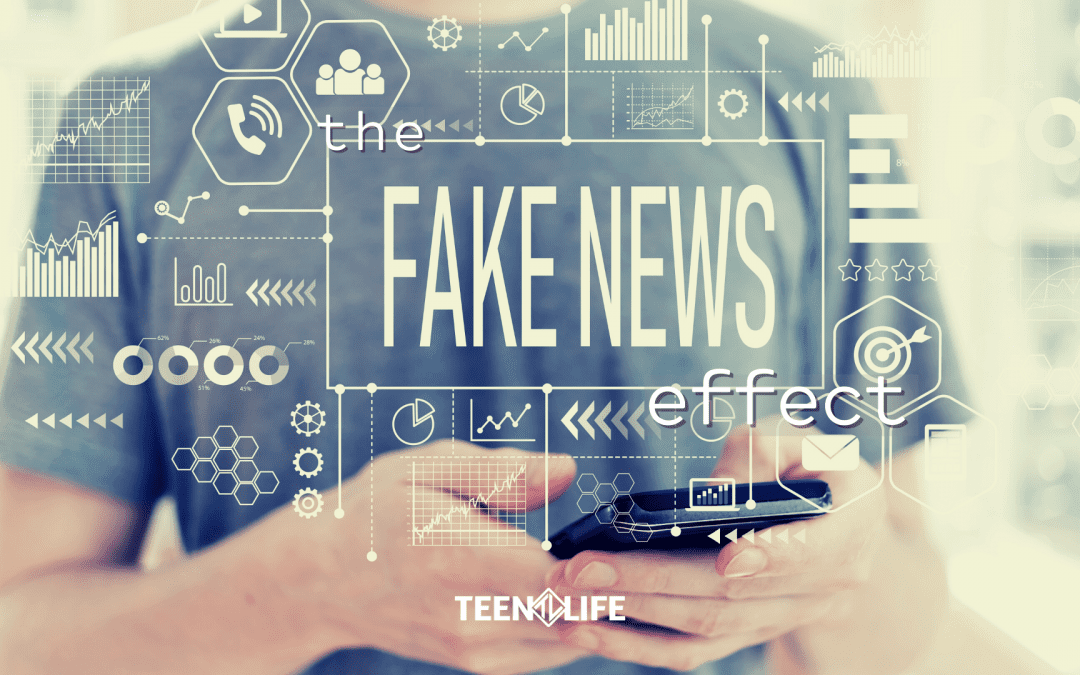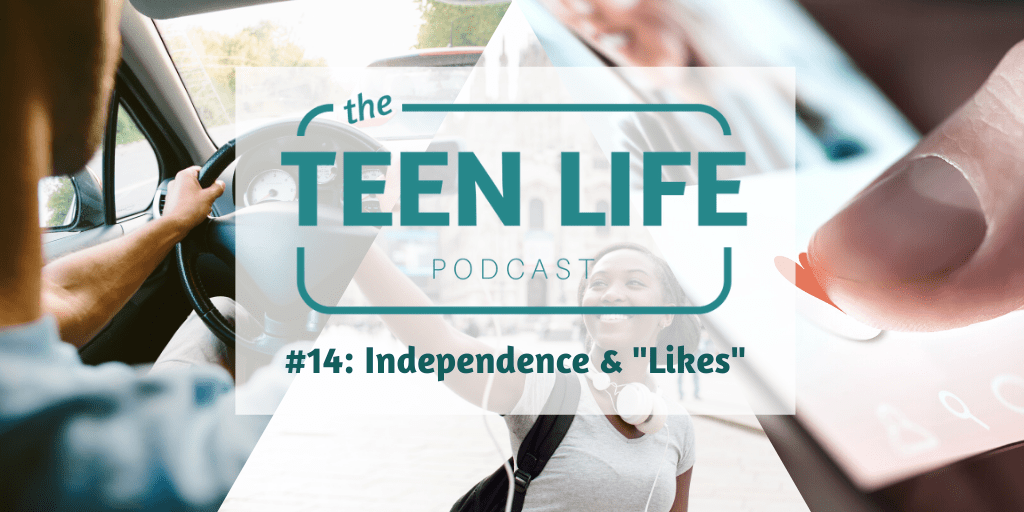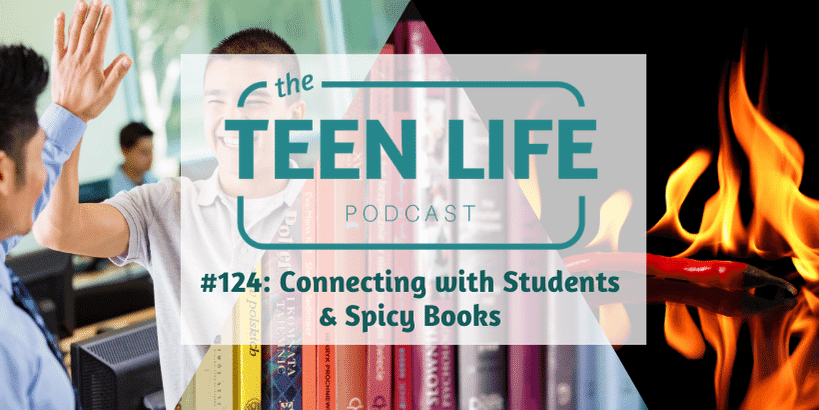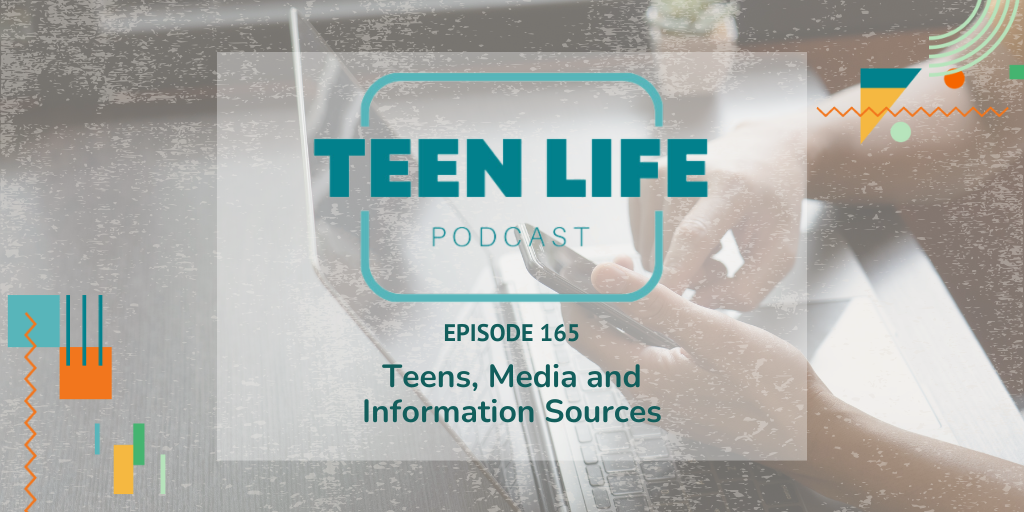
Teens, Media and Information Sources | Ep 165
Podcast: Play in new window | Download
Teens overwhelmingly rely on social media for information and news, but is that the best source?
From social media and search engines to online communities and friends, teens have access to a wide range of media and information sources—but not all are created equal. We’ll explore the landscape of teen information consumption and discuss how we can help guide them to trustworthy content.
Key Question
Where do teens get most of their information? And how can we point them to better resources?
Top Media and Information Sources for Teens:
- Social Media (TikTok): Social media is a major influence, with TikTok leading the charge. Teens often rely on these platforms for quick information, but the content they see is curated by algorithms, which can create echo chambers.
- Friends and Peers: Teens trust the opinions of those around them, and their friends and peers are often primary sources of information.
- Search Engines (Google and YouTube): Quick searches are the go-to for many teens, and YouTube is a major platform for visual learners.
- ChatGPT or AI: More teens are turning to AI tools like ChatGPT for instant answers, but accuracy varies.
- Family: Family still plays a role, but sometimes teens seek other sources when family members aren’t open to discussing certain topics.
- School: While educators provide information, the impact often depends on the topic and the teacher’s approach.
- News (Mostly Digital): Teens may browse news articles online, but they often consume headlines and summaries rather than in-depth reporting.
- Online Communities and Forums (Reddit, Discord): These platforms can provide niche or community-based information, but the quality is mixed.
- Podcasts: Yes, podcasts are becoming a valuable resource for teens, offering a mix of entertainment and education.
Social Media & Information Overload:
Perspective Shift
Are we missing the mark?
A critical question for us as mentors: Are teens seeking information elsewhere because we aren’t willing to have difficult conversations? It’s important to create spaces where teens feel comfortable discussing challenging topics without fear of judgment. If they don’t get the information they need from us, they’ll turn to other, possibly less reliable, sources.
TL Tips & Takeaways:
Ask Questions:
Encourage teens to share where they get their information and ask them about their thought process. Show interest and create an open dialogue.
Teach Fact-Checking Skills:
Walk them through how to find reliable sources and how to cross-check information. Empower them to be critical thinkers.
Recommend Neutral News Sources:
Direct them to trusted, unbiased news outlets like Associated Press, Reuters, or NPR. These sources provide factual reporting without sensationalism.
Read Episode Transcript
Karlie Duke (00:08)
Where do teens get most of their information and how can we point them to better resources? Okay, we got a big question today that we’re gonna talk about and mostly because honestly, I think our teenagers would probably get pretty defensive about this one too. But it’s something that we’re seeing a lot of when I was growing up, there were very few source at mostly library or Wikipedia was the big one of like, don’t trust Wikipedia. But now our students have access to so many sources, so many resources that they’re going a lot of different places to find information. And especially if you are a school person trying to make sure that what they’re turning in, what they’re talking about is correct and a good source, but this is a great lesson to teach teenagers too.
So what do all think?
Caleb Hatchett (01:07)
I mean, it’s super interesting. yeah, just how much it’s changed even since like I was in school versus like, when I’m calling y ‘all old, when y’all were in school, you know, but
Tobin (01:16)
Wow. Wow. Wow.
Karlie Duke (01:18)
That’s so rude.
Caleb Hatchett (01:19)
Like, you know, I you know, we had max in class like middle school all the way through high school And so you just have access to more throughout the day I think too like the interesting thing that I’m seeing with a lot of teens is kind of differentiating like opinion from fact just because so much of what that they’re seeing and like Intaking like especially through social media which like I know we’ll kind of get into like what are the sources that teens are getting their info from like Social media is a big one and I think like whenever you’re intaking that much
Karlie Duke (01:33)
Mm -hmm.
Tobin (01:34)
Mm.
Caleb Hatchett (01:49)
info, you can kind of get in the headspace of, okay, what I’m hearing is fact, even though it’s a person’s opinion or just a different side on a story. And so that’s kind where I’m seeing it. But no, I’m super excited to kind of get to dive into this topic and talk about it.
Tobin (02:06)
Yeah. And I think to piggyback on that, I mean, I am old and it’s like, thought I was, don’t know why I was thinking about today, but you know, when I was in middle school and high school, high school as much as definitely middle school, we used to go to the library as a class to quote-unquote research for papers. And that included like using the one computer on campus for internet, you know, or the
Caleb Hatchett (02:28)
Mm.
Tobin (02:34)
Encyclopedias. So if you are a youth listening, encyclopedias is kind of like an online, you know, knowledge, but in a book. so, so yeah, I mean, like, it’s, it’s crazy because like, one that also dictated like how you wrote, cause it’s like, Hey, if I, don’t, mean, like, again, y ‘all don’t remember this because y ‘all didn’t do this, but like, I literally chose papers on like, how much does the encyclopedia talk about this? How can I, know, or how many books are in the library on this? And now you have this wealth of knowledge, which is great, but
Karlie Duke (02:41)
You
Caleb Hatchett (03:02)
Yeah.
Tobin (03:03)
Everything that you did back then was strictly factual or it was very obvious. It was an opinion. Whereas now you just don’t know. Even Wikipedia can be changed by, by strangers. So, it’s just, it’s just kind of crazy how everything’s at the fingertips now, but also there’s a lot of misinformation out there as well, which is crazy.
Karlie Duke (03:24)
Okay, so let’s get into what are some of the top sources for teens. And the first one I wanna submit because we’ve already mentioned it is social media. But I think specifically TikTok.
Tobin (03:35)
Mm
Caleb Hatchett (03:38)
Yeah. TikTok’s crazy. Like with like their search engine and what you’re seeing now, like is on videos. If a topic is talked about, it’ll have a little like magnifying glass.
with a topic that you can like then click on and it’ll tell you what the video is talking about or like things like that that like is crazy. And it’s gotten like better, but like there’s still some flaws, but like that’s wild too. That like, you don’t even necessarily have to go out and search for something. Like it’s just a click of a button away. If you get on one TikTok about a certain subject, you can just click and then find way more info about it.
Karlie Duke (04:14)
Mm
Tobin (04:16)
I got to be honest, there’s many times that I won’t know about like a current event or like something going on. And then I’ll see it on Tik TOK. And it’s like, and then I get on a rabbit hole of like, why is this person on trial? And then it’s like, you know, there’s there and it seems like we kind of like go through these waves of things that we get super like invested in. like, you know, murder cases or, some sort of like, like,
Caleb Hatchett (04:21)
Yeah.
Tobin (04:44)
tensions in certain areas or wherever it may be. And there’s a lot of times like, like there’s things that I would never know about if it wasn’t for social media, putting it in front of me. And, and it’s like across the nation, like, and then it’s not that I shouldn’t, you know, I should put my head in the sand. not that I can’t be, you know, researching and looking at that kind of stuff, but there’s a lot of times that that stuff puts it in front of me on its own. And like, and and I wouldn’t know it about it otherwise, which is just, it is a weird thing to think about.
Caleb Hatchett (04:54)
Yeah.
And even as an adult, it’s fun. Cause you know, if it’s talking about like Riz or the thing that you don’t understand, like they’re using like lingo, it’ll have the search bar. And a lot of times you can click it and it’ll take you to another video of someone explaining what it is. So that’s, I’ve even found it somewhat useful just with that. But I think teens are using it differently than that.
Karlie Duke (05:11)
That’s it.
Well, I just don’t think teens are watching the news. They’re not going to news websites. They don’t have that on their phone. What they’re doing is they’re going to X and seeing news things come across in real time.
Tobin (05:38)
Mmm.
Caleb Hatchett (05:38)
No.
Snapchat has a whole page for that stuff too, yeah.
Karlie Duke (05:48)
Yes, or they’re following different accounts like celebrity accounts or gossip accounts or stuff on Instagram. And that’s how they’re getting their news. When something big happens, they go look for there instead of maybe what adults would consider reputable news sources. But I mean, I do this too. If, if my internet is out, I go to X first and type in is AT &T out of service. Like that’s how I find out where things are happening. And I’m
Caleb Hatchett (06:12)
Yeah.
Karlie Duke (06:16)
obviously on the upper older end of that. that’s where our teenagers are looking to or we’re looking at a new car right now. I’m going to TikTok and putting in comparisons. What does that look like? Because I know that’s a short form way for me to get information. And that’s a silly example because that doesn’t necessarily matter as much if it’s true or not. Then if someone’s going and looking at.
Caleb Hatchett (06:32)
Mm
Karlie Duke (06:40)
politics or a big world event that’s happening and they’re listening to someone that has no expertise talk about it on TikTok. But that’s where a lot of our teens are getting their news and getting their sources.
Caleb Hatchett (06:52)
And I think a lot of that is like a microcosm of just kind of the shift of how we intake information now of like how teens into like, you know, like Tobin said, you’re used to like reading, like if a, if a teenager has a question on like a user’s manual of like how to set something up, odds are they’re going to look up a video instead of trying to read through.
the instructions on how to do it just because that’s how information is in taken now. And so like, it’s interesting to like how even across the board on like searching things and information about things, I find that teens would rather have watch a video than read something about it.
Karlie Duke (07:26)
Mm -hmm.
Tobin (07:27)
I gotta be honest. I’m not much different in that area either. So, you know, and I, and I’m 40. So I think, I think it’s a shift in, in also like, you know, you, Carly, you were saying that adults, you know, the below us or the kids below us are not watching the news. I don’t watch the news like, because I don’t think news is the same either. And so in also because the way that information was being presented in the past,
Caleb Hatchett (07:30)
No. Me neither.
Mm -mm.
Tobin (07:55)
has to kind of get with the times or else they’re going to be left behind. I look at newspapers. Like newspapers are essentially gone now. And I, I mean, I, maybe I was an old person when I was 13 and now I’m not an old person, but like, used to read the newspaper every day at school. Like I would like get the sports page and take it with me to school. And like, I can’t tell you the last time I even put my hands on a newspaper and that, and so like some of that too is that’s why you will see like,
Caleb Hatchett (08:10)
Hmm.
Yeah.
Tobin (08:22)
these long time organizations like CNN, MSNBC, Fox news, whatever it may be that they are getting in the game with Snapchat and Apple news and Tik Tok and whatever it may be, because they know that that’s how that’s, they got to come, they got to meet the people where they’re at.
Caleb Hatchett (08:36)
Right.
Karlie Duke (08:37)
When I think two things worth mentioning, you’re talking about newspapers. Now, if someone sends me an article to, I don’t know, Wall Street Journal, New York Times, you get a limit on how many articles you can read before it starts to charge you. And our teens are like, I don’t have time for that. And so some of it is access. And then I think another piece, like for example, my husband is huge into sports. He doesn’t have time to sit around and wait to watch Sports Center at the end of the day to figure out what happened all day.
Caleb Hatchett (08:49)
Yeah.
Mm -hmm.
Karlie Duke (09:05)
when he can get on social media or X, think is where he mostly looks at sports and he can know real time what’s happening all the time. Like people, has other friends who will send him stuff days later. He’s like, yeah, I knew about that exactly when it happened because that’s where I get my news. And so in some ways there are positives to that. But I think as we’re gonna keep talking, we’ve got to figure out how can we make sure that they’re checking those sources to make sure they’re right.
Tobin (09:23)
Mm
Well, and another positive thing about that is what teens and with everybody is in those situations, like instead of getting like your blanket news, like, or your blanket MSNBC or blanket ESPN, whatever it may be, you can pay for services. Like I’ll use sports as an example. Like I can subscribe to the athletic, which is an online news source where that gives me anything I want, but it’s a monthly fee, you know, but at least I know that that’s where I’m getting all my information. So like that’s like, can, you can even like.
what’s the word I’m looking for? You can even like, itemize and prioritize what you want instead of getting like the blanket, like I’m going to watch the 10 o ‘clock news and at 10 35 I get sports, you know, that kind of thing.
Karlie Duke (10:10)
Mm -hmm, yeah. Okay, so going into other things, search engines, obviously Google, I think YouTube, similar to social media, but is also used as a search engine if students are looking for tutorials or news or someone to sit and explain a little more long form. That’s where they’re going.
Caleb Hatchett (10:10)
Yeah.
Yeah.
I think too, the interesting thing with search engines right now, especially like with Google, what I’m noticing is like, you’ll search for something, click on the first one. And there’s times I’m like, what, this is a bad source. And you go back and it’s add. So like people can pay to put their link and like, if there’s keyword search, put it at the top. And so like,
Karlie Duke (10:42)
Yeah, it’s a sponsor.
Caleb Hatchett (10:51)
Like it’s just interesting now how you’re kind of having to scroll past the first three to get to the real top hit. And you know, if you’re a student, something like that, I mean, not necessarily saying that those top links are just wrong. They may not be as good or effective as the ones further down. So it’s just interesting.
Karlie Duke (11:08)
Mm -hmm. I think Caleb also brought up before we started recording chat, GPT, and AI is also one. And I know we use this. I mean, sometimes for work, I’ll put in, hey, what are good resources for this topic? And chat GPT will answer that or they’ll ask it a question. They will, I know we’ve mentioned this on the podcast before when we’ve talked about AI, but I know chat GPT.
in particular like says at the bottom, basically fact check. Like we’re not responsible if it’s not true. So you need to fact check everything that we give you. Now, I also think if staying in like the online part, online communities and forums are also where people, where teenagers get stuff. So Reddit, Discord.
Tobin (11:39)
Mm
Caleb Hatchett (11:40)
Mm -hmm.
Yeah.
Karlie Duke (11:57)
depending on what they’re looking for. And then obviously the more in -person touch. So friends and peers is where they’re getting information. They’re getting it from family, they’re getting it from school. Maybe they’re getting it from podcasts, depending on what kind of podcasts they’re listening to. And podcasts are also a great resource, especially if you’re wanting to dive deeper into a topic, to have it on the go, to put it in your ears when you’re doing something else that they can get sources that way.
Tobin (12:11)
Mm
Caleb Hatchett (12:12)
Mm
Karlie Duke (12:26)
I do think, as you can tell, just based on the amount of time that we spend on it, social media is the dominant influence. I mean, that is where most of their information comes from. And we kind of touched on this, but that is curated by algorithms. And so that’s something to keep in mind too, that your teenagers are often in kind of an echo chamber. I think we’re seeing that right now a lot with politics too.
Tobin (12:33)
Yeah, for sure.
Caleb Hatchett (12:33)
Mm
Tobin (12:44)
Mm
Karlie Duke (12:55)
is you tend to see the same opinion over and over and over again based on your algorithm. So you might not be getting both sides of a story like you might from other sources, which can be an issue for our teens.
Tobin (13:07)
for sure.
Caleb Hatchett (13:08)
I think like too, even with like, especially politics, like that’s a lot of their ad campaign marketing right now is just pushing that into like social media and into algorithms and things like that. And so, I mean, like it’s almost inescapable right now. Like,
Karlie Duke (13:19)
Mm -hmm.
Caleb Hatchett (13:25)
your team is, if they’re on social media is in taking some sort of news and information, whether they’re like actively in taking it or not. Like it’s, there on those platforms. And so, you know, and even with that, going back to like what we talked about, like with a TikTok search feature, like we were talking about before, like how a lot of that can be wrong. Like I think
Karlie Duke (13:48)
Mm -hmm.
Caleb Hatchett (13:49)
Carly had a story that I’m sure she’ll tell. then like even along with, you know, social media, like fake news and just, we’ve talked about it before, like fake. I see it a lot in sports. see like a lot of, you know, they’ll take like bar stool or like a certain reputable, like actual news outlet, like for sports. And we’ll change like one letter on it and then be like,
Jalen Hurts ACL out for the year. And you’re like, what? And then you read the comment site. It’s fake. So like, it’s either people like intentionally being fake, just to get like views or clicks or fake, whether they know it or not.
Karlie Duke (14:21)
Yeah.
One AI has made that even more thing. sent, which I knew it was fake when I sent it to him, but I’ve been getting every now and then fake press conferences. I don’t know if y ‘all have seen that where they’re like dub over voices of athletes where they’re like.
Caleb Hatchett (14:41)
Yes.
Tobin (14:42)
Yeah.
Karlie Duke (14:46)
calling people names or saying really funny stuff. And I sent one to Josh and I knew it was fake and he was like, you know that’s not real. But if you’re not paying attention, you might start sending that around and not realizing, hey, this is AI generated. And like Caleb was saying with the TikTok search feature, so a lot of times if you’re on a video, it’ll pop up like a magnifying glass and something to search.
And a lot of times that comes from the comments. That’s not necessarily like fact. what they’re talking about. So I’ve come across a few videos where the poster has kept the name of a celebrity or the name of the restaurant that they’re complaining about anonymous. But the TikTok search feature will put a name in there and everyone was and then everyone assumes that it’s that person when that’s not even true. And so you can go down this rabbit hole. I saw this happen with a restaurant that someone was complaining about a restaurant.
And then I went to that restaurants. like searched it and looked it up. And then I went to their Instagram and they had like made a story about like kind of poking fun at the Tik TOK because they’re like, Hey, that’s not us, but everyone’s assuming that it’s us because of the Tik TOK search feature. So that’s a conversation too, to have with teams like say, Hey, if you are on Tik TOK, do you see the search feature? Do you know what it means? Do you always consider that factor? Do you look into it more?
Tobin (16:08)
Well, and speaking of looking into that, legitimately, I’m asking you guys as adults with real jobs and you know, real lives. If someone tells gives you information, like have y ‘all ever been trained on how to fact check in this, in this like technology age and stuff? Like, do y ‘all even know how to fact check as adults? Cause honestly, like I, I barely do. And it’s only because I had a granddad that was very
Karlie Duke (16:08)
And that’s where, no, it got opened.
Tobin (16:37)
weird about this stuff and kind of taught me how when I was in high school, but like, that’s the thing is like, if we’re not teaching our students, Hey, you can’t believe everything that you’re reading in any topic off of the internet and off of social media and stuff like that. But here’s how you can find that out. Like a lot of people are going to take whatever they see at face value. And so like, and I think that, I mean, I have friends that are in that boat that probably don’t know how to fact check.
Karlie Duke
I think that’s a great question Tobin of do we even know how to fact check? And that’s something, I don’t know if I’m doing it right. I have looked into it before of I’ve even asked questions or like looked up now I’ve Googled it. So who knows how relevant that is. But like when it comes to news, what are the most neutral news sites to start getting information that’s not as biased? Like those are things that I think of. Cause I think you can find one of the problems with this.
One of the problems with this subject in particular is you can find any article that’s gonna back up your point of view. I mean, like it is very easy to go find either side, either extreme, but if you wanna know like more close to the facts, like making sure that you’re looking at reputable sites, and I don’t really wanna answer that for everyone listening here, that’s something I think you need to look into and have a conversation with teenagers, but one question I do wanna pose is: Are teens seeking other sources of information because we aren’t willing to have those conversations with them.
Tobin
I think it depends on the household. You know, there’s some households, like, I mean, it’s not the same thing, but like my grandparents watched a certain news station solely because of the weatherman that was there. like, man, like total sidebar, like people are loyal to their weathermen. And so like, if, the household is a certain way,
I could see it either way. could see it as a, that’s, that’s where they get their news. But I could also see it as, well, you know, especially as a teenager, well, I don’t like what mom and dad thinks. So I’m going to now go the opposite end of the spectrum. And the next thing you know, you have like differing things happening. And so like, I do think that that’s, that plays a huge part in it, or is the household actually having conversations about finding your own, you know, finding correct sources or your own voice in that situation too. But the household plays a huge part of that, in my opinion.
Caleb Hatchett (01:56)
I think too, what I’ve noticed is like students are just not as willing to ask questions, like just in general anymore. I think like a lot of that, especially like in this age is you want to, because you can be so connected, you want to seem educated on a subject and asking a question means, you know, in their mind means I’m not.
And so it’s just this sense of, if I can’t, I feel like I have to educate myself, like my way without letting people know that I have like these questions, because I’ll be looked down upon or viewed as like, you don’t know the answer to that. And so, you know, I think a lot of ways that like, you know, as parents or even as youth leaders is just making a safe space and just even modeling to them, like questions and like, Hey, have you ever thought of this? And, you know, I just know as.
Because I’m a student minister, we’re kind of going through the whole story of the Bible this year and every, every lesson I start out and small group, I start out with, it’s okay to ask questions and it’s okay not to have the answers to those questions. Like it’s fine. Like it’s going to be okay. Like whenever you’re encountering the Bible, whenever you’re encountering the world and faith and navigate, you’re going to have questions. And so just modeling that like it’s okay not to know everything and it’s okay.
Karlie Duke (03:53)
Let’s look it up together.
Tobin
Yeah, the great Ted Lasso said, be curious, not judgmental. I mean, yep, very wise guy.
Yeah, that’s good.
Karlie Duke (04:19)
We love curiosity here. And that is getting into our kind of tips and takeaways for this question and the subject of ask questions. And just like Caleb was saying, ask them in a way that makes them feel safe and not stupid. Cause I think if a teen comes to you and makes some statement that they saw on social media, instead of being like that as a stupidest thing I’ve ever heard, like where did you get that information?
Caleb Hatchett (04:33)
Mm. Yeah.
Karlie Duke (04:45)
Ask it in a way that’s like, really? Can you send me that video? I love to watch it. Hey, have you done more research into this? Find maybe a good rule of thumb is like, find me five sources that back up that claim. Like five more reputable, not just TikTok, like, or three, like go to three different news sites. Sometimes if I see something online, I’ll like actually go and Google it and be like, is this actually happening from multiple sites? Not just one to make sure that I’m not just assuming something and sharing that information. Cause like you’re saying, Caleb, they don’t wanna be wrong. And so let’s teach them how to make sure that they’re confident in the information that they’re putting out. And so that’s kind of the second piece to that is talk through practical places to get reliable information, teach them how to fact check, give them neutral news sources. Someone I did look it up, Associated Press, Reuters, NPR are typically considered more neutral.
Tobin
You got, you got to find stuff that’s not like usually opinion related it and more factual, like, like, is, which AP is a good and Routers are a good example of that of they’re presenting a story and the facts of the story and not an op ed from someone on their team, like, like other resources do. Yeah.
Caleb Hatchett
And also like encourage teens, like read, read both sides, you know, like yes, find a neutral one, but like, if there are opinion pieces, read both sides of the opinion and just kind of, you know, just get as much info and as many sides as you can just to kind of help expand and do like,
Yeah, I think it’s just how you approach it and just making them feel safe and not just immediately like what and feeling like attacking and being like, because then it turns into an argument. doesn’t need to be an argument and just making sure that they realized they’re on the same team. And two, like, it’s just even with funny things, I know a while back, like was going around that Helen Keller didn’t exist. Right. Like, yes. Like, and like, that’s just a microcosm of everything. Yeah.
Tobin
We talked about this on the podcast. That she wasn’t actually blind and deaf. Yeah.
Caleb Hatchett (07:00)
of like, there’s no like, it’s to the point of like teenagers and everything, it’s them processing and like, going through the curiosity of like, there’s no way. It just to kind of not laugh it off immediately and just be like, well, okay, let’s look into Helen Keller’s story because that does sound crazy. I mean,
Tobin
Karlie’s still not convinced.
Karlie Duke
Mm
Well, I don’t know. I’m just saying there are some convincing TikToks out there that make me ask questions. But I think that’s great. I think this is the perfect opportunity to have conversation with your students. And you would rather teach them and model for them now how to do this well so that when they leave, when they graduate, when they are out of your class, that they feel equipped to do this on their own. And this is a skill that they’re going to take with them on and on and on.
And so have a great conversation with the teen today about where they’re getting their sources and what that looks like. We have more exciting episodes coming up in this season of the Teen Life podcast, so make sure that you’re subscribed on YouTube or wherever you listen to podcasts. And once again, we want your questions. So reach out on social media or email us at podcast@teenlife.ngo to submit your question and we’ll see you next week.
Links & Resources:
- Teen Life Podcast: Helen Keller Conspiracy
- Teen Life Blog: The Fake News Effect
- News Sources Mentioned: TikTok | SnapChat | Wikipedia | YouTube | ChatGPT | X | Reuters | The Associated Press | NPR

Karlie Duke
Communications Director

Tobin Hodges
Program Director

Caleb Hatchett
Podcast Host
Karlie Duke | Director of Communications
Karlie has always had a heart for teenagers. Through her role at Teen Life, she loves to showcase the amazing stories coming out of Support Groups, but she is especially passionate about helping adults and teenagers find connection. Karlie has a BS in Communications with a minor in Family Studies from Abilene Christian University.
Caleb Hatchett | Podcast Co-Host
Caleb loves helping teenagers take ownership of their faith and relationships. He graduated from Abilene Christian University with a degree in Youth and Family Ministry and is currently Student Ministry Director at Jenks Church in Oklahoma.
Tobin Hodges | Program Director
Tobin’s entire career has been centered around students and teens from all walks of life. He has a passion for helping teens be their best selves. As Program Director, he loves working directly with school staff and students through Teen Life Support Groups. Tobin has a Bachelor’s Degree in Music from Texas Tech University.
